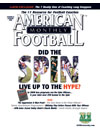AMERICAN FOOTBALL MONTHLY THE #1 RESOURCE FOR FOOTBALL COACHES
Article CategoriesAFM Magazine
|
The 7 Deadly Sins of Coaching Long Snappersby: Michael Parker© More from this issue How many big games end with one team winning a nail-biter by only a few measly points? And how many of those games could have gone the other way, if that kicker had just made that one kick or if that punter couldíve gotten a little bit more on that one punt? Or if that one snap hadnít been off and yet, how many coaches really know how to teach their specialists so they can make that difference? Long snapping has often been looked at as a skill that players either have or they donít. And coaches normally just banish the snappers, along with their kicking comrades, off to the sideline to practice while they focus all their attention on the other members of the team. And in the process these well-meaning coaches likely commit some or all of the seven deadly sins in coaching long snappers. Ben Fuller has made it ....The full article can only be seen by subscribers. Subscribe today!
|
|
|||||||
| HOME |
MAGAZINE |
SUBSCRIBE | ONLINE COLUMNISTS | COACHING VIDEOS |
Copyright 2025, AmericanFootballMonthly.com
All Rights Reserved





